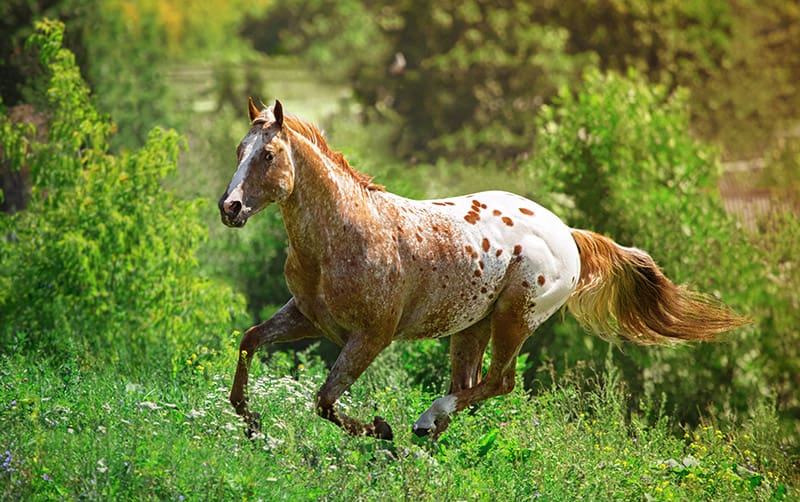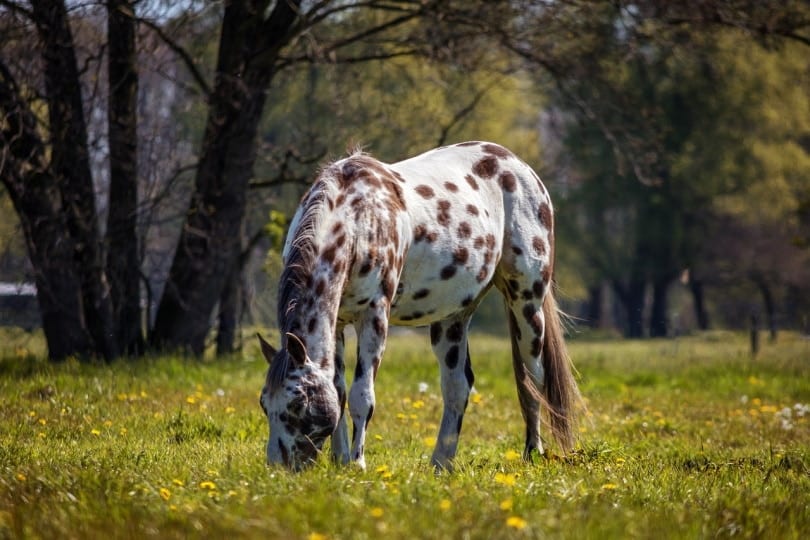The Appaloosa is an American breed that was developed by the Nez Perce Indian tribe!
The Appaloosa horse is known for its spotted patterning. Spotted horses have been part of history for thousands of years, with leopard-spotted horses dating back to the stone age in Europe. The spotted horses probably arrived in America with the Spaniards in the 16th Century and they eventually reached Northern America.
Developed by the Nez Perce Indian tribe, the Appaloosa are native American horses. Their most defining feature is their spotted coat, which can be in five precise patterns: blanket, snowflake, leopard, marble, and frost. White settlers originally referred to them as the “Palouse horse”, the name of a river that runs through the states of Washington and Idaho. Eventually the name turned to Appaloosa.
After the defeat of the Nez Perce Indians by the U.S. Army in 1877, the number of Appalossa declined. Of the horses captured by the army and many were shot and a few sold, though during the indians retreat some of them escaped or were left behind. In the ensuing years, settlers used them for farming, but as a distinct breed they were virtually forgotton. After about 60 years, interest in the breed was again revived, and the Appaloosa Horse Club was founded in 1938. Today the Appaloosa is one of the most popular breeds in the United States. There are over 65,000 registered horses.
Scientific Classification
| Kingdom: | Animalia |
| Phylum: | Chordata |
| Class: | Mammalia |
| Order: | Perissodactyla |
| Family: | Equidae |
| Genus: | Equus |
| Species: | caballus |
Horse Breeds
The Appaloosa are a light horse breed. Light horse breeds generally weigh under 1,500 pounds. They are typically used as riding horses for leisure and trail riding. Being agile and swift, many are also used on the racetrack, in the show ring, and for work on the ranch.
Light horses are grouped in a couple of different ways, one being the continent or country where they originated from. They are also grouped according to training, classified as either a stock type, hunter type (sport horse), saddle type, or ‘other’. A body type is generally attributed to each class, with the ‘other’ classification being a bit of an odd ball. It includes those that are color breeds or those that may fit a body type of one of the training classes, but not be used for that type of training. In some cases the ‘other’ types can also include those that may fit into more than one of the type groups.
The horse class the Appaloosa fits into is both the stock type and the hunter type class, and it is also considered a color breed.

Horse Backgrounds
Spotted horses have been around for hundreds of years prior to the Appaloosa horse. The spotted color is due to a hereditary gene that can appear with any body color, but most commonly the roan color. The spotted horses probably arrived in America with the Spaniards in the 16th Century, and they eventually reached Northern America, where the Nez Perce Indian tribe began to breed them.
The Appaloosa breed are native American horses. They were developed by the Nez Perce in Oregon during the 18th Century. In 1877, the Nez Perce were wiped out by the U.S. Army, but the Appaloosa lived on. The breed was revived when the Appaloosa Horse Club was founded in 1938.
Since the renewed interest in the Appaloosa, crosses with other breeds were introduced to inprove various characteristics. Today there are three main breeds that are allowed for outcrosses by the Appaloosa Horse Club; the Arabian, the Quarter Horse, and the Thoroughbred. The Appaloosa is currently one of the most popular breeds in the United States with over 65,000 registered horses.
Description
Appaloosas generally stand between 14.2 and 15.2 hands high. Their most defining feature is their spotted coat, which can be in five precise patterns:
- Blanket – The most common pattern is the blanket, which is a white or spotted area only over the hind end.
- Leopard – The leopard pattern is dark spots over a white background that covers the whole body.
- Snowflake – The snowflake pattern consists of white spots on a dark background over the whole body.
- Marble – Marble is a mottling over the whole body.
- Frost – Frost is a white speckling on a dark background over the whole body.
Appaloosa’s have mottled (pink and black mixed) skin on the muzzle and around the genitals, and the sclera. The membrane around the eye is white. Their feet are distinguished by having vertical light and dark stripes. The mane and tail are notably sparse, which is thought to be a result of the Nez Perce’s desire to keep their tails thin to prevent them from getting snagged in brush.
Horse Care and Feeding
Appaloosas require a moderate amount of feed. They are known to be a very sound breed and have few lameness problems. A fairly low-maintenance breed that does fine in most settings, they will do equally well in pasture or in a barn or box stall.

Horse Training and Activities
The Nez Perce originally bred the Appaloosa for hunting and defense. Today, they are primarily used for pleasure riding, rodeo, and working cattle, although they can also be used as a sport horse for racing and jumping, and for trail riding. They are known for their calm and pleasant disposition, which makes them easily trainable.
Common Health Problems
Appaloosa horses are known to be a very sound breed. They have few lameness problems. There are couple of rather specialized afflictions they are prone to including:
- Congenital Stationary Night Blindness (CSNB) – Appaloosas can be afflicted by congenital stationary night blindness (CSNB) which causes them to have virtually no night vision. The disease is thought to be caused by the LP gene that creates certain Appaloosa coat patterns. Any horse that is homozygous for the LP gene can be afflicted. The disease is present at birth and is non-progressive. Clinical signs are confusion, spookiness, and reluctance to move in places with low lighting. The only way to test for CSNB is to have a veterinary ophthalmologist perform an ERG (electroretinogram) vision test.
- Equine Recurrent Uveitis – They tend to have watery eyes and may need to wear a fly mask to keep the flies out of their eyes. Appaloosas can also be more prone to equine recurrent uveitis than other breeds. This is an immune inflammatory response of the uveal tract of the eye. Clinical signs are puffy, watery eyes, red blood vessels on the sides of the eye and lids, and squinting. It can cause damage to the retina if it goes untreated.
- Sunburn – The pink skin that is exposed on an Appaloosa, especially the white patches on their muzzles, is susceptible to sunburn so applying sun block to these areas is advisable. Providing them with shade also helps.
Availability
The Appaloosa is readily available throughout the United States.
Featured Image Credit: Seaq68, Pixabay
